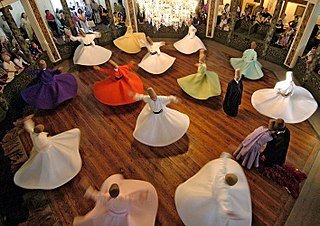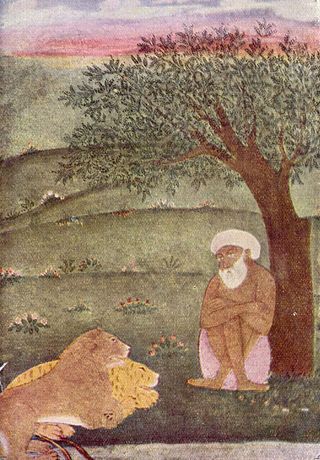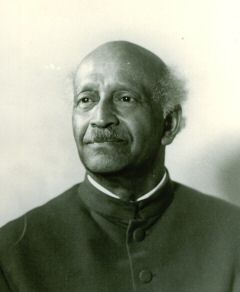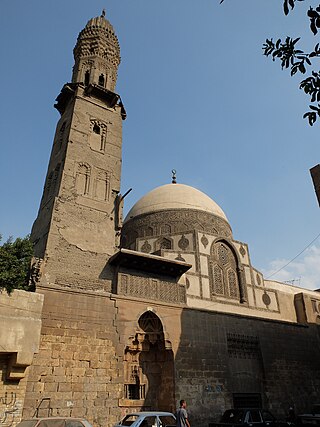Related Research Articles

Jalāl al-Dīn Muḥammad Rūmī, or simply Rumi, was a 13th-century poet, Hanafi faqih (jurist), Islamic scholar, Maturidi theologian (mutakallim), and Sufi mystic originally from Greater Khorasan in Greater Iran.

Sufism is a mystic body of religious practice found within Islam which is characterized by a focus on Islamic purification, spirituality, ritualism, and asceticism.
Sama or SAMA may refer to:

The Chishti order is a Sufi order of Sunni Islam named after the town of Chisht, Afghanistan where it was initiated by Abu Ishaq Shami. The order was brought to Herat and later spread across South Asia by Mu'in al-Din Chishti in the city of Ajmer.

Sama is a Sufi ceremony performed as part of the meditation and prayer practice dhikr. Sama means "listening", while dhikr means "remembrance". These performances often include singing, playing instruments, dancing, recitation of poetry and prayers, wearing symbolic attire, and other rituals. Sama is a particularly popular form of worship in Sufism.

Dervish, Darvesh, or Darwīsh in Islam can refer broadly to members of a Sufi fraternity (tariqah), or more narrowly to a religious mendicant, who chose or accepted material poverty. The latter usage is found particularly in Persian and Turkish (derviş) as well as in Tamazight (Aderwic), corresponding to the Arabic term faqīr. Their focus is on the universal values of love and service, deserting the illusions of ego (nafs) to reach God. In most Sufi orders, a dervish is known to practice dhikr through physical exertions or religious practices to attain the ecstatic trance to reach God. Their most popular practice is Sama, which is associated with the 13th-century mystic Rumi. In folklore and with adherents of Sufism, dervishes are often credited with the ability to perform miracles and ascribed supernatural powers. Historically, the term Dervish has also been used more loosely, as the designation of various Islamic political movements or military entities.

Qawwali is a form of Sufi Islamic devotional singing originating in Hindustan. Originally performed at Sufi shrines or dargahs throughout Hindustan, it is famous throughout Pakistan, India, Bangladesh and Afghanistan and has also gained mainstream popularity and an international audience as of the late 20th century.

Sufi whirling is a form of physically active meditation which originated among certain Sufi groups, and which is still practiced by the Sufi Dervishes of the Mevlevi order and other orders such as the Rifa'i-Marufi. It is a customary meditation practice performed within the sema, or worship ceremony, through which dervishes aim to reach greater connection with Allah. This is sought through abandoning one's nafs, ego or personal desires, by listening to the music, focusing on God, and spinning one's body in repetitive circles, which has been seen as a symbolic imitation of planets in the Solar System orbiting the Sun.

Islamic music may refer to religious music, as performed in Islamic public services or private devotions, or more generally to musical traditions of the Muslim world. The heartland of Islam is the Middle East, North Africa, the Horn of Africa, Balkans, and West Africa, Iran, Central Asia, and South Asia. Due to Islam being a multi-ethnic religion, the musical expression of its adherents is vastly diverse. Indigenous traditions of various part have influenced the musical styles popular among Muslims today. The word "music" in Arabic, the language of Islam, is defined more narrowly than in English or some other languages, and "its concept" was at least originally "reserved for secular art music; separate names and concepts belonged to folk songs and to religious chants".

Divan-i Kabir, also known as Divan-i Shams and Divan-i Shams-i Tabrizi, is a collection of poems written by the Persian poet and Sufi mystic Rumi. A compilation of lyric poems written in the Persian language, it contains more than 40,000 verses and over 3,000 ghazals. While following the long tradition of Sufi poetry as well as the traditional metrical conventions of ghazals, the poems in the Divan showcase Rumi’s unique, trance-like poetic style. Written in the aftermath of the disappearance of Rumi’s beloved spiritual teacher, Shams-i Tabrizi, the Divan is dedicated to Shams and contains many verses praising him and lamenting his disappearance. Although not a didactic work, the Divan still explores deep philosophical themes, particularly those of love and longing.

The Sama-Bajau include several Austronesian ethnic groups of Maritime Southeast Asia. The name collectively refers to related people who usually call themselves the Sama or Samah ; or are known by the exonym Bajau. They usually live a seaborne lifestyle and use small wooden sailing vessels such as the perahu, djenging (balutu), lepa, and vinta (pilang). They also use medium-sized vessels like the jungkung, timbawan and small fishing vessels like biduk and bogo-katik. Some Sama-Bajau groups native to Sabah are also known for their traditional horse culture.

Quṭb al-Aqṭāb Khwāja Sayyid Muḥammad Bakhtiyār al-Ḥusaynī, Quṭb al-Dīn Bakhtiyār Kākī was a Sunni Muslim Sufi mystic, saint and scholar of the Chishti Order from Delhi, India. He was the disciple and the spiritual successor of Mu'in al-Din Chishti as head of the Chishti order. Before him the Chishti order in India was confined to Ajmer and Nagaur. He played a major role in establishing the order securely in Delhi. His Dargah is located adjacent to Zafar Mahal in Mehrauli, and is also the venue of his annual Urs festivities. The Urs was held in high regard by many rulers of Delhi like Iltutmish who built a nearby stepwell, Gandhak ki Baoli for him, Sher Shah Suri who built a grand gateway, Bahadur Shah I who built the Moti Masjid mosque nearby and Farrukhsiyar who added a marble screen and a mosque.

A Sufi lodge is a building designed specifically for gatherings of a Sufi brotherhood or tariqa and is a place for spiritual practice and religious education. They include structures also known as khānaqāh, zāwiya, ribāṭ, dargāh and takya depending on the region, language and period. In Shia Islam, the Husayniyya has a similar function.

Musharaff Moulamia Khan was born in Baroda (India) on 6 September 1895 and died in The Hague (Netherlands) on 30 November 1967. Не was the youngest brother of Inayat Khan, and shared his delight in music. While in his teens he had just come to Calcutta to study and be under the influence of his brother when Inayat was called away to America, and Musharaff was left alone. Within a year, however, he also journeyed to the west, where he joined Inayat and became one of 'The Royal Musicians of Hindustan.'

Ahmad Ghazālī was a Sunni Muslim Persian Sufi mystic, writer, preacher and the head of Al-Nizamiyya of Baghdad. He is best known in the history of Islam for his ideas on love and the meaning of love, expressed primarily in the book Sawāneḥ.

Al-Shustari was an Andalusī Sufi poet, sufi mystic, and scholar known for his contributions to Islamic mysticism and religious poetry.
Molbog is an Austronesian language spoken in the Philippines and Sabah, Malaysia. The majority of speakers are concentrated at the southernmost tip of the Philippine province of Palawan, specifically the municipalities of Bataraza and Balabac. Both municipalities are considered as bastions for environmental conservation in the province. The majority of Molbog speakers are Muslims.

Fanna-Fi-Allah is a Canadian–American group which plays Qawwali, a form of Sufi devotional music popular in South Asia. Formed over two decades ago, the ensemble is recognized for its commitment to maintaining the authentic practices of Qawwali.

The Maizbhandari, or sometimes Maijbhandari, order or tariqa of Sufism within Sunni Islam was founded in the late 19th century by the Bengali Sufi saint Ahmad Ullah Maizbhandari from Chittagong. It is the only Sufi order to have originated from within the Bengal region, and, as an indigenous movement, it has continued to enjoy significant popularity through to the 21st century.

The Madrasa of Amir Sunqur Sa'di, also commonly known as the Mausoleum of (Sheikh) Hasan Sadaqa, is a medieval Mamluk-era madrasa structure and mausoleum in Cairo, Egypt. It was originally built between 1315 and 1321 CE by amir Sunqur Sa'di. Sunqur was forced to leave Egypt in his lifetime and was never buried there, but a sheikh known as Hasan Sadaqa was later buried in it and therefore the building is often known by his name. From the 17th century onward the complex was converted into Mevlevi Sufi lodge and is open today as the Mawlawiyya Museum or Museo Mevlevi.
References
- ↑ Gribetz, Arthur (1991). "The Samā' Controversy: Sufi vs. Legalist". Studia Islamica. 74: 43–62. JSTOR. doi:10.2307/1595896. JSTOR 1595896.
